DJCAD Degree Show 2019: Jewellery and Metalsmithing
What unites and divides this year’s exhibition? All but two of the exhibitors are exclusively jewellers, although a further two suggest that their eminently wearable pieces might also be considered as small sculptural works. In terms of benchwork, there’s casting, a fair bit of scoring and folding, and a considerable use of oxidised metal (and a little of patination), granulation and quite often the contrasting whiteness of unpolished silver. That is not to say these are being used similarly, of course. Thematically, there are environmental and ethical issues. Work is drawn from land, sea and cityscapes, developing both emotionally-charged and scientifically-derived studies. It’s pleasing to see this excellent department continuing to enjoy national competition success, particularly the Goldsmith’s Precious Metal Grant, allowing more noble metalworking than might otherwise be possible.
Anchoria Janet’s investigation of extremities, in her Femme Brutale collection, juxtaposes a Brutalist architecture framework with crochet, in a series of pendant earrings in the main. Something sharp, and something deceptively fluffy! There has clearly been some sound curatorial wisdom, and the shows flow very evenly; in this case into Lorna Romanenghi’s laser cut, and folded geometry of Above and Below, which probes the interactions of plants. Her use of Keum Boo (an ancient Korean gilding technique) and mixed metal chain-work is particularly pleasing.
Scoring, folding, and oxidised metal, in wave forms, are Trudi McVey’s response to ‘fluxes of energy found in the natural world’: magnets, light and sound. Whilst McVey describes how she ‘illustrates the chaos’, my impression was of well-maintained control and subtle use of lovely engraving.
Viktoria Georgiev notes jewellery’s roles which traditionally mark life’s important passages, now mainly reduced to the wedding and engagement ring market. This self-proclaimed maker of ‘love jewellery’ uses casting, stones, shells and granulation, with marine symbolism sourced in the legends of the birth of Venus. This is naturally complemented by neighbour Kate Morton’s Tokens of Remembrance, with its tangible and textile approach to loss and grief. Her considerable use of roller-textured metals, particularly as beds for black and white enamels, are suggestive of printmaking. In both cases, it’s interesting to think how we relate to certain jewellery, wearing it against our skin, with greater constancy than clothing.
Isla Keillor’s response to the rural is formed in lithe porcelain vessels, with evidence of fascinating firing techniques. Her supporting photography is beautiful indeed. Beside her work, Denise Lafferty’s urban-focussed Strata finds history in peeling layers of decay, investigating these processes in 3 D printing, and patination in various combinations of materials. Like Keillor, Lafferty’s photographs have great impact. Rebecca Phelps’ Creagan returns us to the shore, studying rock formations. Her use of the ancient technique of chasing, allied with natural patination methods, and her consideration of the ethics behind not only materials but the ways of working makes interesting reading. Milly Munday also looks below the high tide line in her Beachcomber and Ocean Cluster collections, offering tiny beauties of barnacles and more. The former collection utilises 3D printing and casting, and the latter more traditional bench techniques, with granulation, oxidation and stones.
Moving a little inland, Stephanie Galloway’s Escape scrutinises the Tay Rail Bridge’s engineering detail in laser cut wood, metal and more. Her accompanying booklet (an excellent feature of this year’s show) is especially gorgeous.
Andrea Dritschel’s Dark Grace takes the ‘human touch and pollution’ in interesting directions, and whilst there is casting, wire, and granulation, her use of oxidation turns experimental, recording how oxides from earrings transfer onto a dancer’s skin.
For me, the standout show was Allison Meighan’s thorough exploration, teaming research into the Nabateans (an ancient people of Petra), and Mitochondrial DNA, wondering at ‘our shared inner genetic code’. Through boxwork, printing, and many materials, this exhibit intrigued, alloying history, science and creativity in a wholly satisfying way.
That was my choice. Yours may be very different, and there’s only one way to discover!

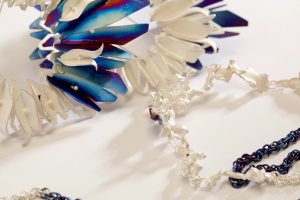
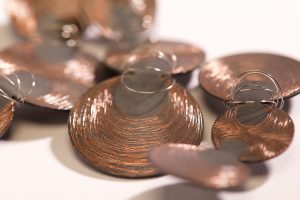
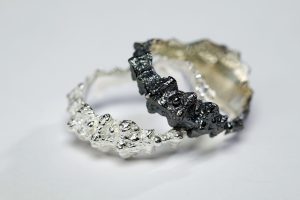
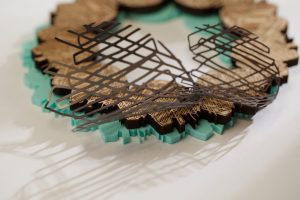
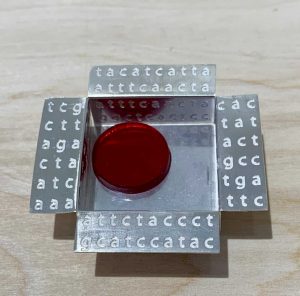
Leave a Reply